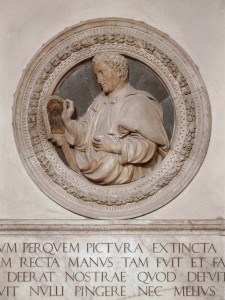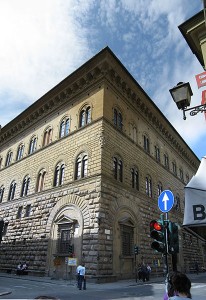
Michelozzo di Bartolomeo
Palazzo Medici, Florence, 1445–57
Photographer: Gryffindor, uploaded to Wikimedia Commons April 2008
The Medici of Florence offer an outstanding example for the way in which calculated spending enhanced and furthered family fortunes and self-identity. The Medici family’s rise to prominence during the early part of the fifteenth century was greatly facilitated by lavish works of art commissioned from local painters, sculptors, and architects. The tradition of visible spending that would affect the welfare of the city was pioneered by Cosimo de’ Medici (1389–1464), who very soon after his death was being celebrated as Pater Patriae—“Father of the Country.”
The word applied Cosimo’s contemporaries applied to his spending on art was “magnificence,” taken from a treatise by Aristotle and used with wide approval:
In our days Cosimo of Florence has renewed the ancient magnificence, both in building temples and villas and in founding libraries. And he has not only imitated, but also in my opinion he was the first to renew the custom of turning private money to public good and using it for the embellishment of his country. . . . Cosimo’s prestige was greatly enhanced both by the villas he built with extraordinary magnificence . . . and by the palace whose construction renewed an ancient and almost forgotten style of building. It seems to me that he has done this so that those who come in the future afterwards might be instructed as to how to build.11
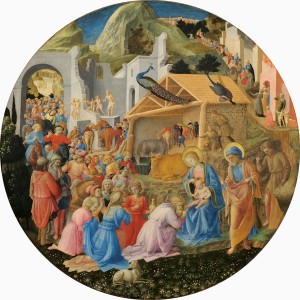
Fra Angelico and Fra Filippo Lippi
The Adoration of the Magi, c. 1440/60
Tempera on panel, diameter 137.3 cm (54 1/16 in.)
National Gallery of Art, Washington, DC, Samuel H. Kress Collection
Image courtesy of the Board of Trustees, National Gallery of Art
In his long and detailed biography of Cosimo, Vespasiano da Bisticci makes it clear that Cosimo was very much aware that buildings and works of art would perpetuate family identity in a way nothing else could:
Cosimo once said that the great mistake of his life was that he did not begin to spend his wealth ten years earlier . . . because, knowing well the nature of his city, he was sure that in the lapse of fifty years no memory would endure of himself or of his house save the few remains he might have built.12
During his lifetime Cosimo focused his spending on building a large and handsome palace that became one of the showpieces of Renaissance Florence. Many objects that were once part of the palace’s interior decoration have been dispersed (see, for example, the Orsini-Medici vase discussed earlier) and are now held in the collections of museums around the world. One aspect of early Medici patronage was the creation of a princely identity for the family by connecting it to the lay confraternity of the Compagnia de’ Magi, a social group composed of well-to-do Florentines. Dedicated to social benefit and acts of charity, they associated themselves with the three kings who came from afar to honor the birth of the Christ Child. A stunning round painting, commissioned by either Cosimo de’ Medici or his son Piero, was on view in the Florentine palace, according to a 1492 palace inventory. From all evidence it was the most prized work in the Medici collection. Painted during the 1440s and late 1450s, begun by Fra Angelico and finished by Filippo Lippi, the tondo shows the newborn Christ Child being honored by the Three Magi. The Magi are depicted in a magnificent procession that was meant to bring to mind the processions of the Compagnia de’ Magi through the streets of Florence, an event held every five years under the auspices and with the financial support of the Medici. The richness and extravagance of the Magi entourage seems intended to echo the magnificence with which the Medici surrounded themselves. On the roof of the shed in the center of the painting are a peacock, an ancient symbol of immortality, and a type of hawk, the goshawk, shown with its prey, signifying superiority and victory over enemies. It has been argued that the two birds were added, in a final reiteration of the propaganda message, after the painting had been substantially completed. The blunt message is that the Medici family is destined for longevity and triumph. Throughout its long history the Medici family was adept at using symbols as a way of making reference to themselves. The peacock and goshawk in the Adoration of the Magi tondo stand as an important early example.
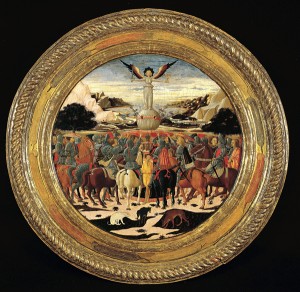
Giovanni di ser Giovanni Guidi
Childbirth tray of Lorenzo de’ Medici with The Triumph of Fame, c. 1448
Tempera, silver, and gold on wood, diameter 92.7 cm (36 1/2 in.)
The Metropolitan Museum of Art, New York
Image © The Metropolitan Museum of Art, New York, NY
Piero de’ Medici, Cosimo’s son, employed a more antiquarian outlook in his patronage, in line with the emphasis on learning and the revival of antiquity that gained currency in Italy during the second half of the fifteenth century. He concentrated his collecting energies on acquiring a fine collection of ancient and modern coins, displayed in his studiolo in specially constructed cases. A medal honoring Cosimo was cast following his death, almost certainly under the sponsorship of Piero, which proclaimed Cosimo “Father of the Country,” following an antique formula first used for Cicero. It has been suggested that perhaps even Donatello may have had a hand in designing the medal. The inscription encircling the profile head of Cosimo on the front of the medal reads MAGNVS COSMVS MEDICES · P P P ·, the three letters P standing for Princeps Pater Patriae (the great Cosimo de’ Medici, prince, father of the country). On the reverse, a female personification of the city of Florence, identified as “Florentia,” is seated on a portable folding chair called a faldstool that is associated with rulers in antiquity. Florentia holds a laurel branch, symbol of peace, in one arm and extends the sphere of rule in the other. The inscription along the outer edge of the reverse reads PAX LIBERTAS / QVE PVBLICA (Peace and Public Liberty). The implication is that Cosimo, assiduously serving Florence, is himself a personification of the city. Florentia’s chair rests on a yoke, which was destined to become a standard Medici emblem that signified service and dedication. The future Pope Leo X, Piero’s grandson, would take up this emblem as a personal device. The medal is known in two versions. The later version adds a further layer of glorification by specifying in its inscription that Cosimo was given the title “Father of the Country” by public decree—COSMVS MEDICES DECRETO PVBLICO P P ·. The portrait in the second version is more idealized. Some of the marks of old age have been smoothed from the sitter’s face, and the head has been given a more rounded, sculptural form.
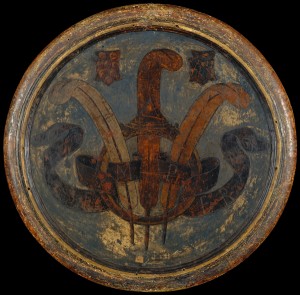
Giovanni di ser Giovanni Guidi
Reverse of childbirth tray of Lorenzo de’ Medici with impresa of the Medici family and arms of the Medici and Tornabuoni Families, c. 1449
Tempera, silver, and gold on wood, diameter 92.7 cm (36 1/2 in.)
The Metropolitan Museum of Art, New York
Image © The Metropolitan Museum of Art, New York, NY
It was with the birth of Piero’s first son, Lorenzo de’ Medici, who was already called il magnifico—the magnificent—during his lifetime, that Medici patronage developed into an extravagant dynastic display. For the event of his son’s birth, Piero commissioned a magnificent childbirth tray, known as a descho da parto, depicting the Triumph of Fame, an allegory drawn from Petrarch’s I Trionfi. Most childbirth trays known from inventories and extant examples appear to have been intended to carry food and gifts into the birth chamber. The Triumph of Fame tray, however, given its large size and extremely fine painting, was unquestionably intended as a showpiece to celebrate the continuation of the Medici line and the alliance of the Medici and Tornabuoni families. Fame, a female figure dressed in classical costume, stands high and confident on a globe, a sword in one hand and a statuette of Cupid in the other, receiving the acclamation of a band of warriors and nobles. The image of Fame for Lorenzo’s childbirth tray was almost certainly chosen to announce that this son of the Medici family was destined to be the leader of the city of Florence. The tray contains an abundance of references to the Medici in coats of arms and imprese. The reverse of the tray, usually not displayed, presents three emblems that were introduced to Medici imagery by Piero and were to become a staple of Medici family decoration: the diamond ring; the three colored ostrich feathers, signifying the three theological virtues, hope (green), faith (white), and charity (red); and the scroll inscribed with the motto Semper, or “Always.”
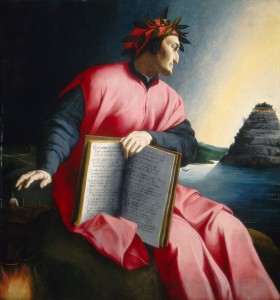
Florentine, 16th century
Allegorical Portrait of Dante, late 16th century
Oil on panel, 126.9 x 120 cm (49 15/16 x 47 1/4 in.)
National Gallery of Art, Washington, DC, Samuel H. Kress Collection
Image courtesy of the Board of Trustees, National Gallery of Art
The patronage of Lorenzo de’ Medici ranged far and wide and was evident on many fronts. His promotion of Florence as a cultural capital resulted in the elevation of Dante Alighieri, Giovanni Boccaccio, and Petrarch to the status of poets emblematic of Florentine cultural achievement. Apparently with Lorenzo’s encouragement the humanist Cristoforo Landino prepared an edition of Dante’s Commedia, published in Florence in 1481, with an extensive commentary that linked Dante firmly to Florence. Landino’s publication would have a long life as the authoritative text of Dante’s poem.
Lorenzo also actively participated in placing idealized portraits of important Florentine men of the arts—including the famed fourteenth-century artist Giotto—along the walls of the cathedral of Florence. Benedetto da Maiano, one of the artists who took part in this project, noted Lorenzo’s intention to make the cathedral a site to proclaim Florentine achievements in the arts:
In 1490 I completed a commission for the Magnificent for the bust of Giotto in the church of Santa Maria del Fiore, and, at the same time, a more perfectly modeled bust of the Medici organist Antonio Squarcialupi. According to the Magnificent, the cathedral which housed, among others, the remains of Brunelleschi, Giotto and Landino ought to become the Pantheon of Florence.13

Attributed to Andrea del Verrocchio
Giuliano de’ Medici, c. 1475
Terracotta, 61 x 66 x 28.3 cm (24 x 26 x 11 1/8 in.)
National Gallery of Art, Washington, DC, Andrew W. Mellon Collection
Image courtesy of the Board of Trustees, National Gallery of Art
Lorenzo has been described as a power broker who actively promoted the fortunes and reputations of Florentine writers and artists. The value of his patronage was broadly acknowledged. According to the writer Poliziano, Lorenzo’s friend and contemporary:
I shall always be at the beck and call of Lorenzo as I am sure he knows better than I, and that he will put me in an honourable position as he always has done and as my fidelity and good services merit.14
Portraiture gave the Medici visibility in the competitive Florentine political and social scene. A handsome portrait bust of Giuliano, Lorenzo’s younger brother, probably from the time of his entry into Florentine public life c. 1475 and attributed to Verrocchio, presents him as confident and arrogant, head held high and turned slightly to the side.
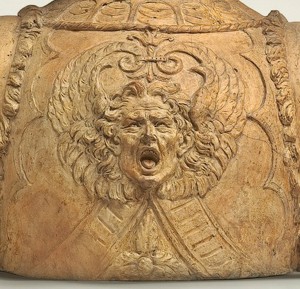
Attributed to Andrea del Verrocchio
Portrait of Giuliano de’ Medici (detail of breastplate), c. 1475
Terracotta, 61 x 66 x 28.3 cm (24 x 26 x 11 1/8 in.)
National Gallery of Art, Washington, DC, Andrew W. Mellon Collection
Image courtesy of the Board of Trustees, National Gallery of Art
A fierce, grimacing mask, emblematic of inner ferocity, is positioned on his breast as part of the decoration of his armor, exemplifying the inner strength and resolve of this Medici prince. Lorenzo, continuing the tradition initiated by Piero after the death of Cosimo, commemorated himself and other members of the family on medals. Toward the end of his life, a medal of Lorenzo was prepared and probably cast around 1489–90. It deliberately echoes in a number of ways the earlier medal of Cosimo, establishing the message of continuity that was stressed over and over again in the patronage of the Medici family. Shown in profile, wearing his hair in the longish Florentine bob of the second half of the fifteenth century, Lorenzo displays the determined expression that speaks of his responsibility both as the leading citizen of the city and as head of the Medici family, in charge of its fortunes and future success.
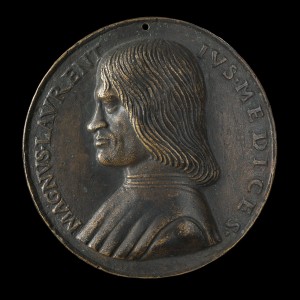
Niccolò Fiorentino
Lorenzo de’ Medici, il Magnifico (1449–92), date unknown
Bronze/late cast, hollow, diameter 9 cm (3 9/16 in.)
National Gallery of Art, Washington, DC, Samuel H. Kress Collection
Image courtesy of the Board of Trustees, National Gallery of Art
The inscription along the outer edge of the medal, framing his head, names him as MAGNVS LAVRENT / IVS MEDICES (The Great Lorenzo de’ Medici). The reverse includes a phrase that assigns him the
formidable role of TVTELA PATRIE (Protection of the Country). On the reverse, a representation of Florentia, identified in the inscription along the bottom of the medal, leans against a laurel tree—laurel being one of Lorenzo’s personal emblems—and holds a lily, symbol of Florence. Taken as a whole, the message is strikingly similar to that of Cosimo’s medal: Florence, under Lorenzo as it was under Cosimo, is protected by the Medici. The medal was widely circulated and is also known in versions that omit the reverse.
![Bertoldo di Giovanni<br /><i>The Pazzi Conspiracy Medal: Lorenzo de’ Medici, il Magnifico (1449–92)</i> [obverse]; <i>The Murder of Giuliano I de’ Medici</i> [reverse], 1478<br />Bronze, diameter 6.6 cm (2 5/8 in.)<br />National Gallery of Art, Washington, DC, Samuel H. Kress Collection<br />Image courtesy of the Board of Trustees, National Gallery of Art](http://italianrenaissanceresources.com/wp-content/uploads/2013/02/RP_171-300x146.jpg)
Bertoldo di Giovanni
The Pazzi Conspiracy Medal: Lorenzo de’ Medici, il Magnifico (1449–92) [obverse]; The Murder of Giuliano I de’ Medici [reverse], 1478
Bronze, diameter 6.6 cm (2 5/8 in.)
National Gallery of Art, Washington, DC, Samuel H. Kress Collection
Image courtesy of the Board of Trustees, National Gallery of Art

Sandro Botticelli
The Adoration of the Magi, c. 1478/82
Tempera and oil on panel, 70 x 104.2 cm (27 9/16 x 41 in.)
National Gallery of Art, Washington, DC, Andrew W. Mellon Collection
Image courtesy of the Board of Trustees, National Gallery of Art
After Giuliano’s death, a touching portrait by Sandro Botticelli of c. 1480 created a poignant image of commemoration. The half-open window behind the bust-length portrait of Giuliano, a device taken from funerary art in antiquity, signifies entry into the world beyond. A turtledove, symbol of mourning, is perched on a dead branch placed on the windowsill, creating a transition between viewer and portrait. Giuliano’s eyes are lowered as if in farewell. The portrait preserves the confident, almost arrogant curl of the lips seen in the terracotta bust that was apparently one of Giuliano’s prominent features.
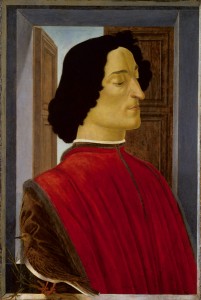
Sandro Botticelli
Giuliano de’ Medici, c. 1478/80
Tempera on panel, 75.5 x 52.5 cm (29 3/4 x 20 11/16 in.)
National Gallery of Art, Washington, DC, Samuel H. Kress Collection
Image courtesy of the Board of Trustees, National Gallery of Art
Botticelli was among Lorenzo’s most favored painters. He produced numerous paintings with important Medici themes in the 1480s and early 1490s, either through the direct patronage of Lorenzo or for other members of the Medici family who were influenced by Lorenzo’s approach to collecting. In view of the flourishing art industry under Lorenzo, this period has been termed Florence’s Golden Age. The theme of the Adoration of the Magi, closely associated with the Medici earlier in the century, continued to be prominent under Lorenzo. Among the examples produced during Lorenzo’s lifetime is a fine work by Botticelli of c. 1480. Unlike the earlier Adoration of the Magi tondo from the time of Cosimo, the elaborate procession has been simplified here, permitting a focus on the perspectival architecture, one of the specialties of Florentine workshops in the 1480s. The painting is known to have been in Rome in the sixteenth century; it may have been sent there from Florence to a Medici supporter or to strengthen family alliances.
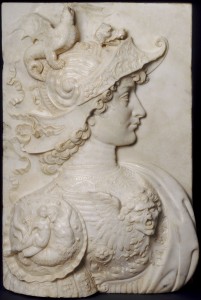
Workshop of Andrea del Verrocchio
Alexander the Great, c. 1483/85
Marble, 55.9 x 36.7 cm (22 x 14 7/16 in.)
National Gallery of Art, Washington, DC, Gift of Therese K. Straus
Image courtesy of the Board of Trustees, National Gallery of Art
Another aspect of Lorenzo’s art policy was the sending of elegantly crafted works of art to foreign rulers as an indication of the high quality of Florentine artistic workshops and of Medici connoisseurship. Bronze reliefs of the ancient heroes Alexander the Great and Darius, king of Persia were sent to Matthias Corvinus, king of Hungary, in the hopes of furthering a political alliance. The reliefs are lost, but marble versions of profile warriors in antique dress may well be copies of the bronze originals; this example, attributed to Verrocchio, is one of the most impressive.

Bowl with arms and devices of Pope Leo X and families allied by marriage with the Medici, c. 1520–1
Earthenware, diameter 36.5 cm; h. 20.8 cm (14 2/5 in.; 8 1/5 in.)
British Museum, London
© Trustees of the British Museum
In the sixteenth century Medici patronage expanded into a larger arena. In 1513 Giovanni de’ Medici, the son of Lorenzo, became Pope Leo X—the first of the Medici popes. The Medici were launched onto a grand stage. While Leo’s patronage belongs as much to the larger issue of the papacy and sixteenth-century Rome as it does to furthering the fortunes of the Medici family, there is ample indication that Pope Leo did not forget his obligation to ensure the family’s future success. A large footed bowl of the type known as a rinfrescatoio, used for washing fruit or cooling wine flasks or glasses, presents Leo X in the context of a network of powerful Medici marriage alliances in both Florence and Rome.
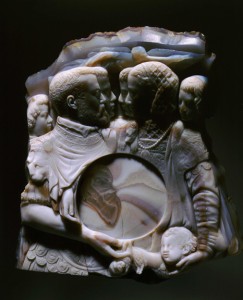
Giovanni Antonio de’ Rossi
Cameo depicting Cosimo I de’ Medici (1519–74) and family, 17th century
Sardonyx
Museo degli Argenti, Palazzo Pitti, Florence
Alfredo Dagli Orti/The Art Archive at Art Resource, NY
On the inside, in the center of the bowl, are Leo’s papal arms presented by celebratory putti. Along the inner rim of the bowl are four Medici devices: the diamond ring with the three colored ostrich feathers and the motto SENPER [sic: SEMPER] (Always); the yoke with the motto SVAVE (Gentle); a wheel held fast with a nail, an image of fixed power; and an eagle with the motto RENOVABITVR, “Renewal.” These are devices used by earlier members of the Medici family, with the exception of the wheel and nail. This last appears to be an invention by Leo himself to refer to the renewal of Medici fortunes, signified by his own elevation to the papacy and the Medici return to power in Florence in 1512 after a period of exile. On the outside of the bowl, Medici arms alternate with the arms of families with whom the Medici had formed important alliances—the Orsini of Rome and the Strozzi and Salviati of Florence. This carefully crafted and impressive bowl, very likely on prominent display in one of the Medici residences, was probably produced to celebrate one particular alliance—the marriage in 1516 of Maria Salviati, a descendant of one branch of the Medici family, to Giovanni dalle Bande Nere, the descendant of another. It was this marriage that was seen as holding the promise of bringing new blood into the Medici lineage. The hope was not in vain. The first-born son of the couple, in 1537, was Cosimo I de’ Medici, who would become the princely ruler of Florence.
Medici self-promotion reached a culmination in the patronage of Cosimo I, the first member of the Medici family to bear the title of duke. With his ascendancy to the rule of Florence in 1537, the position of the Medici as the supreme rulers of Florence would be assured for several centuries. Cosimo I’s patronage was vast and complex. A single example that encapsulates the refinement of taste of the Cosimo court is a grand cameo depicting the duke with members of his family. Cosimo and his wife, Eleonora of Toledo, are shown in the foreground, together with their five sons. An allegorical figure of Fame flies overhead, blowing a trumpet. The couple wraps their arms around a recessed disk, perhaps meant to be filled by a celebratory medal. This exquisite work of art is a direct reference to the grand cameos of imperial Rome, many of which were eagerly collected by the Medici.
![Florentine, 15th century<br /><i>Posthumous medal of Cosimo de’ Medici (1389–1464), Pater Patriae</i> [obverse]; <i>Florence Holding an Orb and Triple Olive Branch</i> [reverse], probably 1465/69<br />Bronze, diameter 7.5 cm (2 15/16 in.)<br />National Gallery of Art, Washington, DC, Samuel H. Kress Collection<br />Image courtesy of the Board of Trustees, National Gallery of Art](http://italianrenaissanceresources.com/wp-content/uploads/2013/03/RP_162-300x147.jpg)
![Florentine, 15th century<br /><i>Cosimo de’ Medici (1389–1464), Pater Patriae</i> [obverse]; <i>Florence Holding an Orb and Triple Olive Branch</i> [reverse], c. 1465/69<br />Bronze, diameter 7.8 cm (3 1/16 in.)<br />National Gallery of Art, Washington, DC, Samuel H. Kress Collection<br />Image courtesy of the Board of Trustees, National Gallery of Art](http://italianrenaissanceresources.com/wp-content/uploads/2013/03/RP_161-300x137.jpg)
